Review & Photography by Manny Manson for MPM
Yet again, another trip back to the Halls in Wolverhampton, tonight it had a peculiar calmness to it as the crow, somewhat sedately filtered in, tonight there was none of the hurried scampering’s of fans trying to get in quickly, to get as close to the barrier as possible, no tonight was an all-seated affair. It was the kind of night where the air already shimmered with seductive anticipation, even before a single note had been played. Most of the audience had come for what was being billed as a rare alliance between two of the greatest guitar voices of the last half-century, Joe Satriani and Steve Vai, they would be joined onstage by fellow guitar heavyweight Pete Thorne, thunder god Kenny Aronoff on drums, and rock journeyman Marco Mendoza on bass and vocals. But before all of that came a support set by someone whose name wasn’t immediately familiar to most, myself included.
Ned Evett, the quiet sorcerer from the shadows, brought an entirely different kind of magic to the Wolverhampton massif. Born in Nashville but raised in the Idaho mountains, Evett was far from the guitar industry’s mainstream corridors. His instrument of choice, a fretless guitar with a fingerboard made of glass, this was something he helped invent and popularise. No frets meant infinite nuance, but also infinite challenge. Every note having to be placed precisely, intonated like a violin. The result was a sound unlike any other, fluid, expressive, alien and ancient all at once, mind boggling but somewhat of an art form that he had mastered.
Evett’s background was steeped in slide guitar, fingerstyle roots, and an almost mystical approach to composition. Albums like Built to Spill: The Normal Years (1993) and Village of the Unfretted (2005), Glass Guitar (2015) All American Radio (2020) and his latest release Strange Kind of Freedom (2024) all pull together to showcase his innate ability to blend cinematic textures with raw storytelling. He won the North American Rock Guitar Competition in 2003, earning praise from legends like Joe Satriani himself. Where Joe and Steve used six strings to tell soaring tales of interstellar romance and struggle, Ned told ghost stories and meditations on the edge of the world. His appearance on this tour, maybe a bit mystical to some, myself included, wasn’t just simply about contrast, it was about being a complement, a side dish by way of a treat which works extremely well when taken with the main course. He embodied the mystery and danger that comes before a storm, help setting the atmosphere for everything that followed.
And what a storm it was.
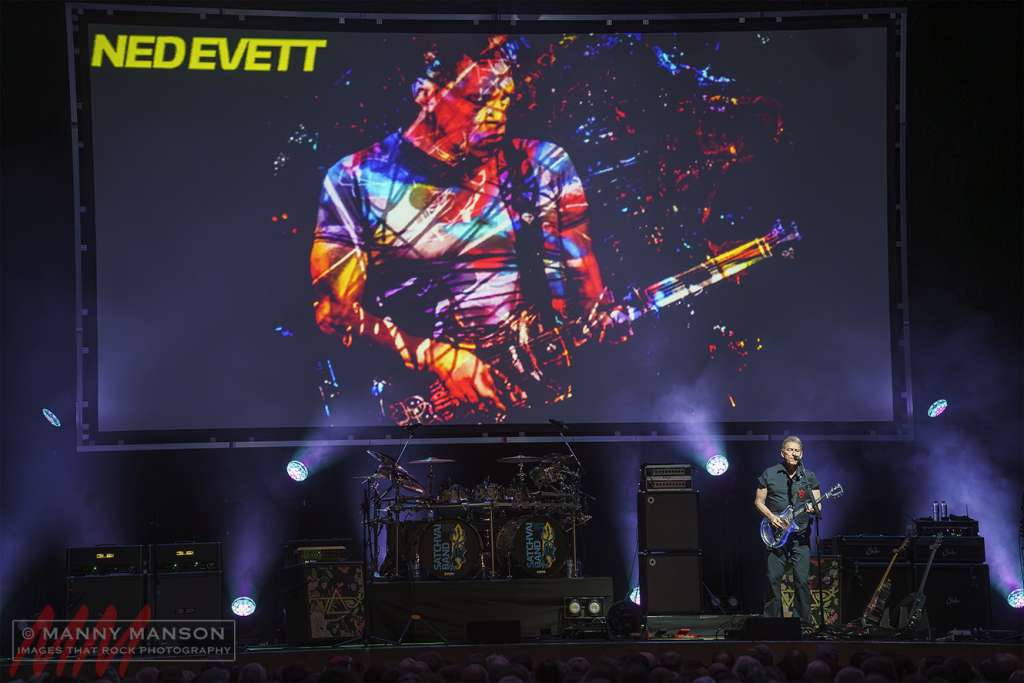
Ned Evett walked out alone, carrying a strange, glistening guitar with no frets and a fingerboard and body seemingly made entirely of glass. He looked like a bluesman beamed in from another planet, unassuming, maybe even slightly dishevelled, not in a Seasick Steve kinda way, this was no red neck, lumberjack shirt wearing hill billy, he was dressed in a dark one piece, short sleeved, dickies style overall with and his logo, in red stitching proudly on display on his left breast pocket, he had an aura, one of confidence and calm, that promised something different. What followed over the next twenty-five minutes was a hypnotic journey through glass and aluminium, rhythm and resonance.
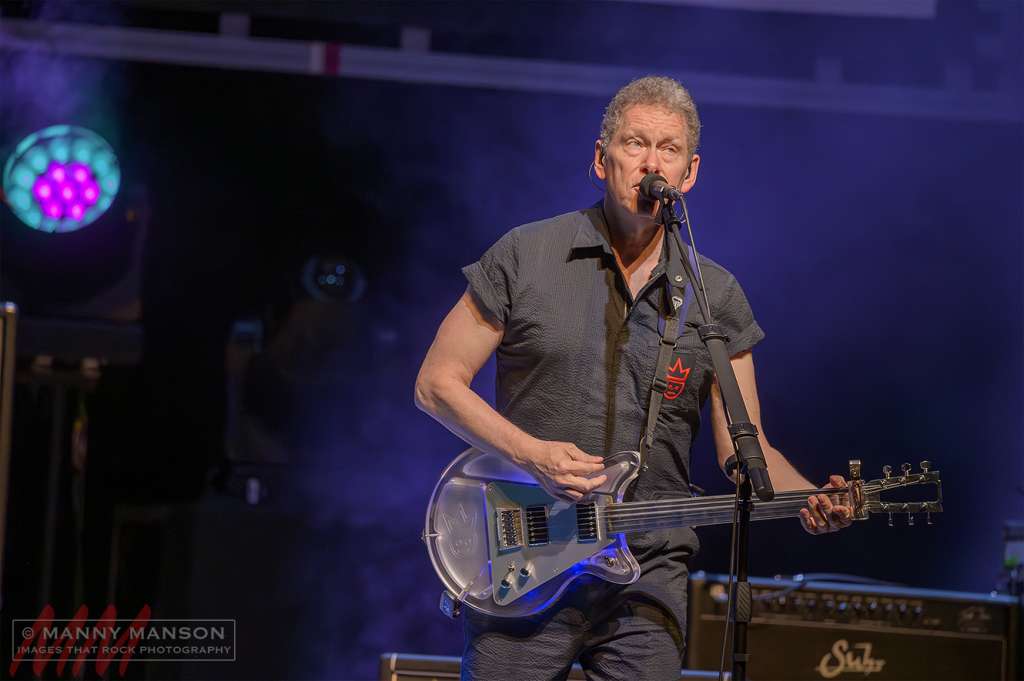
Under a soft blue spotlight and silence thick with curiosity, Ned Evett walked onstage cradling his unmistakable glass-necked resonator guitar. No loops, no effects. Just fingers, slide, and soul. He opened with “Mississippi Ganges,” a swirling fusion of Delta roots and raga spirit. The tune bloomed slowly, built on a droning modal pulse and fretless slide lines that sang like wind over water. You could hear Ry Cooder’s storytelling and John McLaughlin’s cosmic edge, but all filtered through Evett’s peculiar, slippery phrasing. A one-man invocation, earthy, spectral, entrancing.
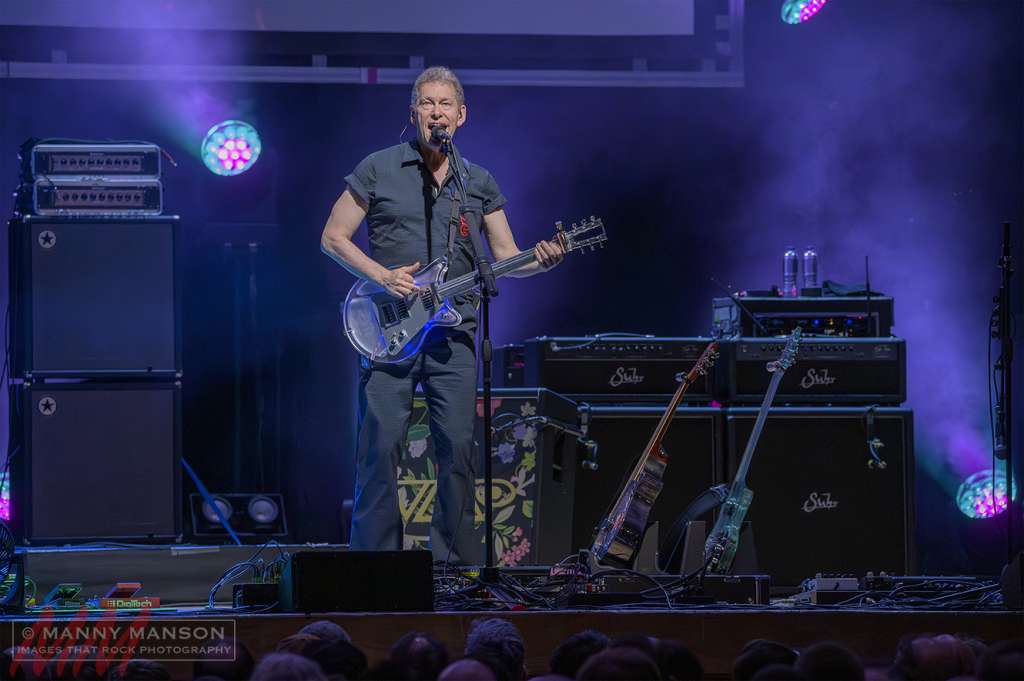
Then came “Good News,” leaner and grittier, walking a crooked blues line with gospel overtones and a twisted grin. Evett’s right hand drove the rhythm with percussive slaps and thumb-thumps while his vocals danced through sharp couplets like, “The good news is I made the news / The bad news is I’m wanted in two states.” The tone was dirty and playful, the slide biting like barbed wire wrapped in velvet. It had teeth — but it also had a knowing wink.
Shifting gears, he dropped into the hushed intimacy of “My Old Eyes,” a stark, vulnerable ballad that held the room still. The guitar breathed soft, wordless sighs under his voice, each phrase gliding between notes as if refusing to land too soon. “They don’t see like they did,” he sang, “but they see what I missed,” and the weight of the line hung heavy in the air. The performance was stripped back, unguarded, and quietly devastating.
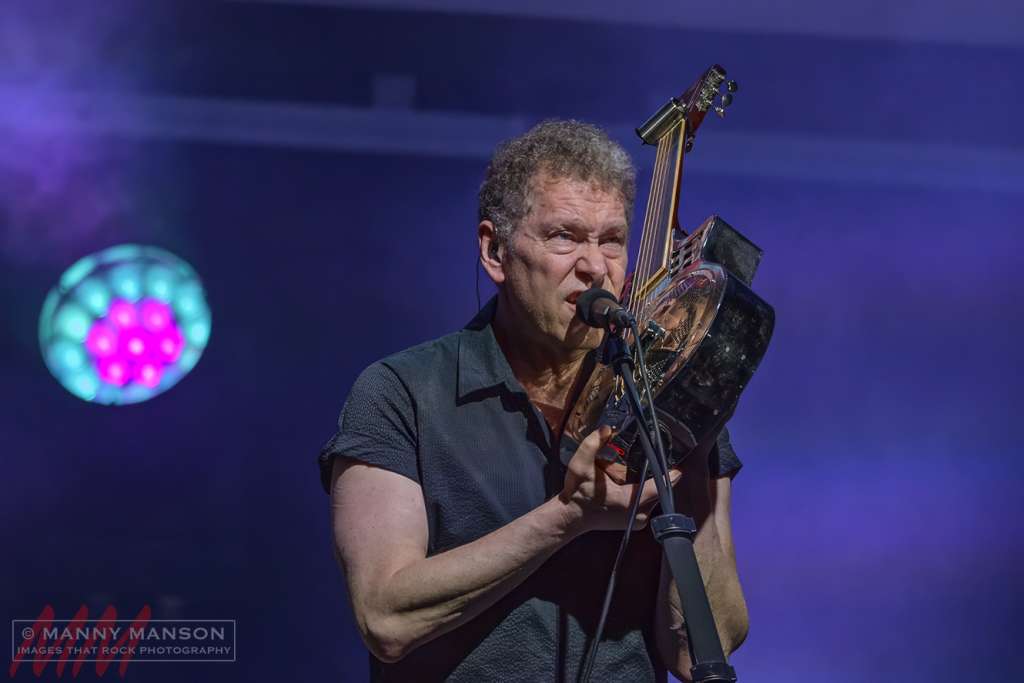
“Mars River Delta 2128” felt as though it had been written not for Earth, but for a terraformed Martian landscape. Stark, pulsing, and full of futuristic echoes. His slide shrieked and chirped over jagged grooves, alternating between swamp and sci-fi. It was atmospheric. You could hear metal against dust, solar wind against rusted hulls, blues in the bloodstream of a dying colony. It was wild, strange, and alive. it was the sound of open skies on a distant, red planet.
“Message to You” returned us to something more grounded, it brought things back down to something heartbreakingly human, melancholic and sweet. There was a late-night warmth to it, his slide playing, is it slide or is he continually adjusting a capo up and down the neck? The sounds evoked the weary storytelling of Ry Cooder, but filtered through Ned’s entirely unique fretless language. It was simple and beautiful, the kind of song that doesn’t ask to be clapped for, it just sits in your lap looking up at you.
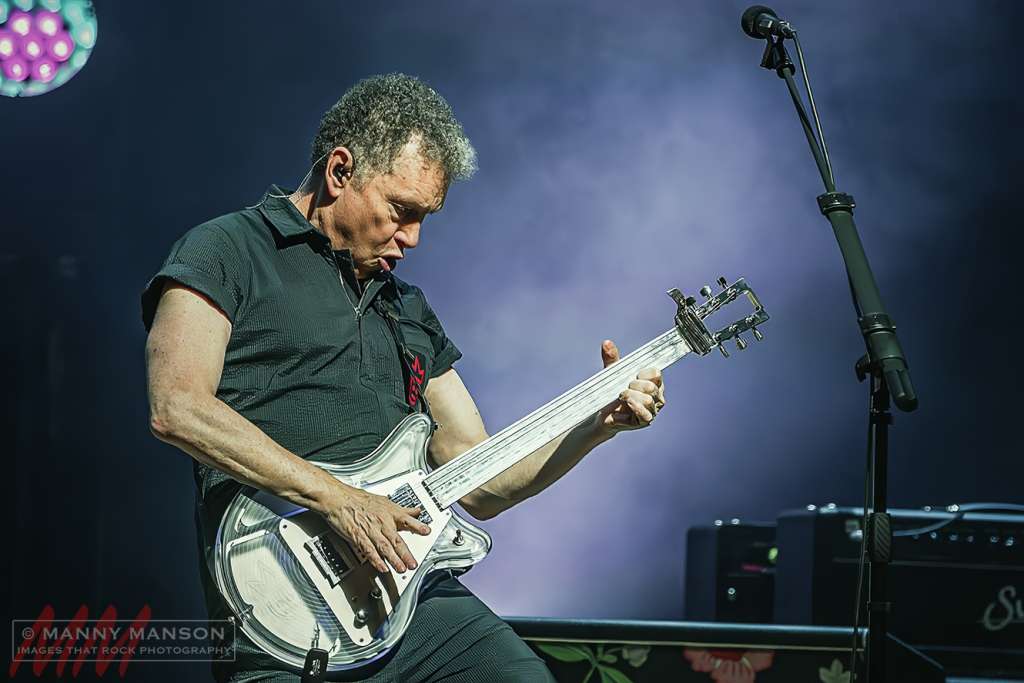
Finally, he tore into “Rockstar,” a snarling, tongue-in-cheek closer that ripped apart the clichés of fame with wit and ferocity. The riff came in jagged and swaggering, half-glam, half-punk, with lines like “Autographs on credit cards / Fifteen minutes of fear.” But in the bridge, “There’s no encore in the mirror / Just the man who pays the tab,” the satire turned inward. The closing solo was a frenzy of fretless fire, ending with a dead-stop palm mute and a wry nod.
A single set, compact and otherworldly, met with generous applause from a seated crowd who hadn’t quite expected to be moved quite in the way they had. The room had been subtly warmed up.
After a brief intermission, it felt about fifteen minutes, the lights dimmed, and the collective hush turned into cheers. The Satch Vi Band had arrived.
Joe Satriani, the archetypal guitar instrumentalist, had always carried with him an air of monk-like devotion to the purity of melody. Born in Westbury, New York in 1956, Satriani was originally inspired by the death of Jimi Hendrix, news that struck him like a thunderclap at age 14 and spurred him to pick up the guitar. His journey would begin not as a performer but as a teacher. In the early ’80s, long before the world knew his name, he was giving lessons to a generation of future stars, Steve Vai among them, along with Kirk Hammett of Metallica and Alex Skolnick of Testament.
Satriani’s breakthrough came with 1987’s Surfing with the Alien, an album that didn’t just defy expectations, it rewrote them, it was a musical moment I heard played on Australian radio whilst on Bondi Beach in December 1987, I went straight into record store and bought the album. Instrumental guitar records weren’t supposed to chart, yet here was an album where every track, from the blistering “Satch Boogie” to the cinematic “Always with Me, Always with You”, stayed as memorable as any vocal rock song of its time. Over the decades, Joe went onto carve out a discography that balanced technical bravado with lyrical, melodic songwriting: Flying in a Blue Dream (1989), The Extremist (1992), Is There Love in Space? (2004), and Shockwave Supernova (2015) among them. His tone, always articulate, smooth, glassy on top with a creamy sustain, this became a benchmark for lead guitar. No player could be so fast and yet so melodic, so virtuosic and yet so soulful.
Steve Vai, on the other hand, was the showman, the surrealist, the mad scientist of the guitar. Born in Carle Place, New York in 1960, just a short drive from Satriani’s own hometown, Vai had been a guitar prodigy from the start. At age 18, he sent a transcription of one of Frank Zappa’s complex guitar solos to the man himself. Zappa, suitably impressed, hired him as a transcriber, and soon Vai was onstage as “stunt guitarist” in Zappa’s notoriously difficult band, a trial by fire that made most other gigs look like kindergarten.
When Vai released Flex-Able in 1984, it was already clear he was a different kind of animal. His big commercial breakthrough came in 1990 with Passion and Warfare, a psychedelic, spiritual, and technically mind-blowing album that gave us “For the Love of God,” “Erotic Nightmares,” and “The Audience Is Listening.” Vai played with David Lee Roth on Eat ’Em and Smile, formed the supergroup G3 alongside Satriani and others, and even crafted grand concept albums like Real Illusions: Reflections (2005) and The Story of Light (2012). His most recent work, Inviolate (2022), showed no signs of creative fatigue. His playing could flutter like silk, roar like thunder, or do both in the same phrase. Where Satriani aimed for the stars, Vai often seemed to be dragging alien signals back from another dimension. His signature style—heavy on legato, whammy bar theatrics, and harmonic manipulation, is as instantly recognisable as his angular eyebrows and custom-built Ibanez guitars.
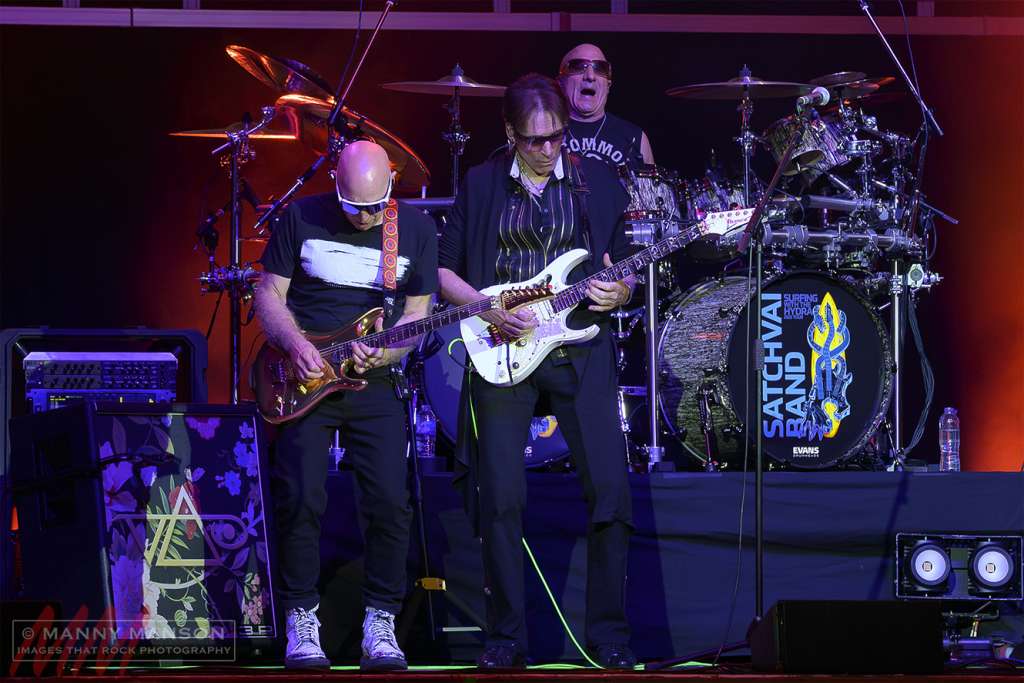
So, from a hallowed murmur of fans chatting amongst themselves, came a roof lifting cheer, it was like the flick of a switch moment. A sudden blare of blue lights and a percussive groove signalled the start of “I Wanna Play My Guitar,” their 2025 single that had originally featured Glenn Hughes on vocals. On this night, it was Marco Mendoza who grabbed the microphone, and to no one’s surprise, he carried it with confidence and vocal grit. Mendoza’s voice has that righteous rasp, a voice dripping in confidence garnered by years on the road, the kind that could cut through a dense wall of distorted guitar and still carry a melody. As the rhythm locked in tight, Kenny Aronoff hammering his kit with atomic precision, Vai and Satriani traded verses on their instruments like boxers circling a ring, each lick a jab, each solo a power shot. Pete Thorne added grit and sparkle in equal measure, his tone slightly more mid-focused, sliding into harmonies and stepping forward for concise, emotive fills that reminded everyone he wasn’t just there to hold the rhythm down, he was there on merit, he was part of the conversation.
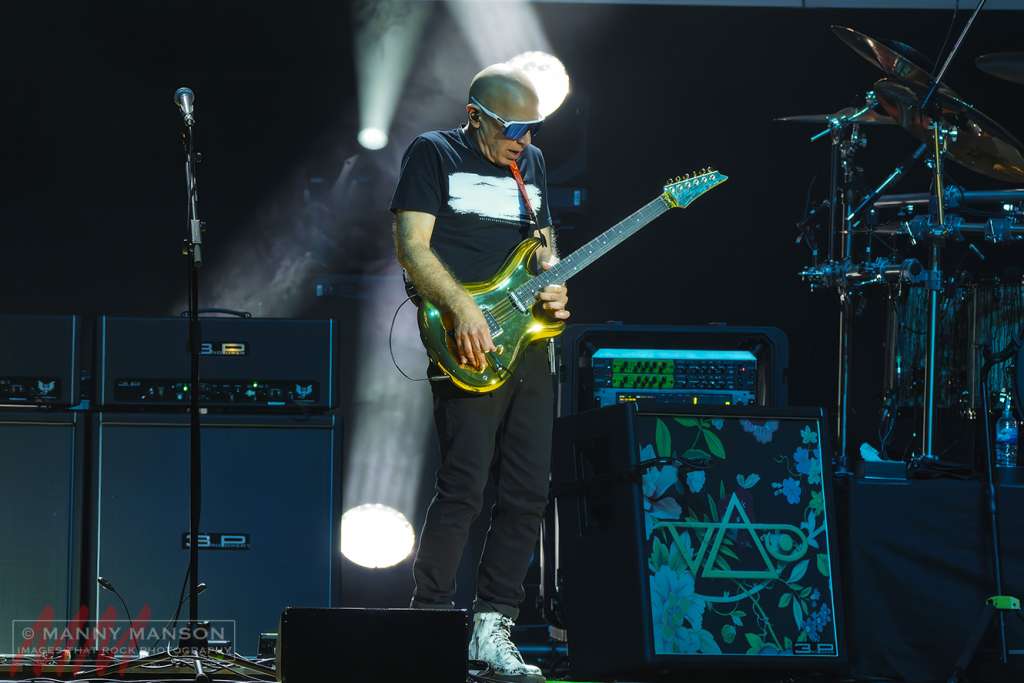
Without any pause, they moved into “The Sea of Emotion, Part I,” an instrumental that pulled everything back into something cinematic. This wasn’t a song so much as a movement, ambient chords blooming like nebulae behind a slow, aching melody played in harmony by both Satch and Vai. Joe’s tone here was unmistakable: rich, almost vocal, drenched in delay and overdrive just enough to sustain without losing clarity. Vai’s counterpoint danced just above, a pure, clean Strat like tone with his signature bar flutter and those perfectly micro-bent notes that seem to cry like words unspoken.
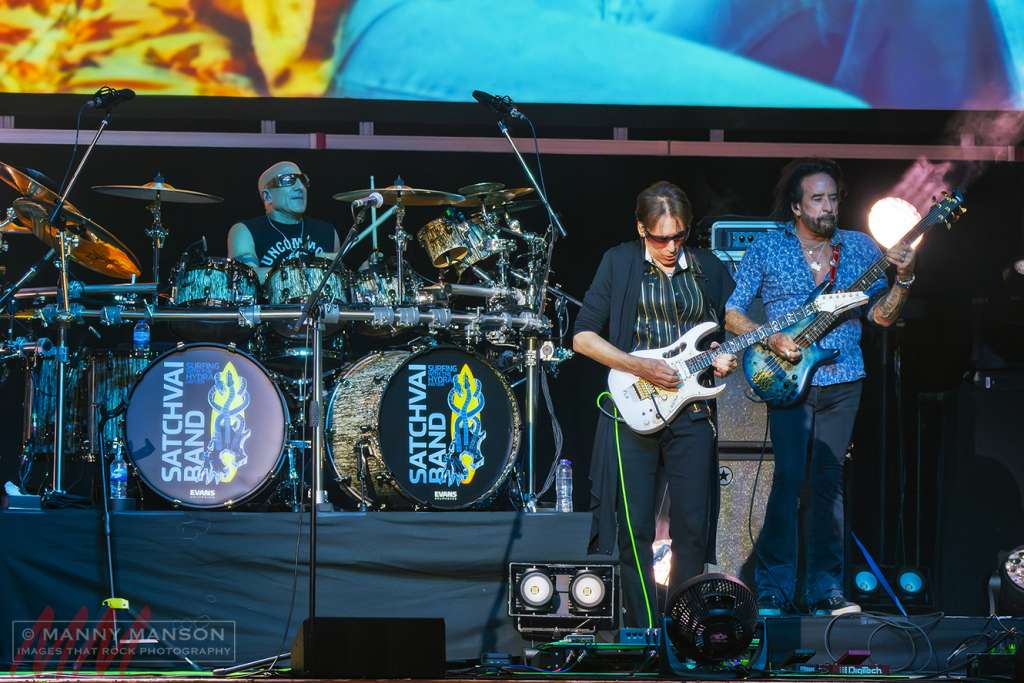
After a dramatic pause, Satriani quietly stepped offstage, and Steve Vai launched into “Zeus in Chains,” a track from his Inviolate album from 2022. With a stripped-down arrangement, the full strangeness and serpentine nature of the song could be felt. Angular rhythms, whammy pedal squawks, and tight staccato riffing gave way to floating harmonics and modal detours. The crowd, silent and focused, watched every flick of his fingers on the fretboard of this 7-string behemoth, as if witnessing alchemy, exactly how it was intended, whilst conjuring he slowly gazed around the room from behind his shade, lifting his leg on occasion to ensure the pitch was indeed perfect.
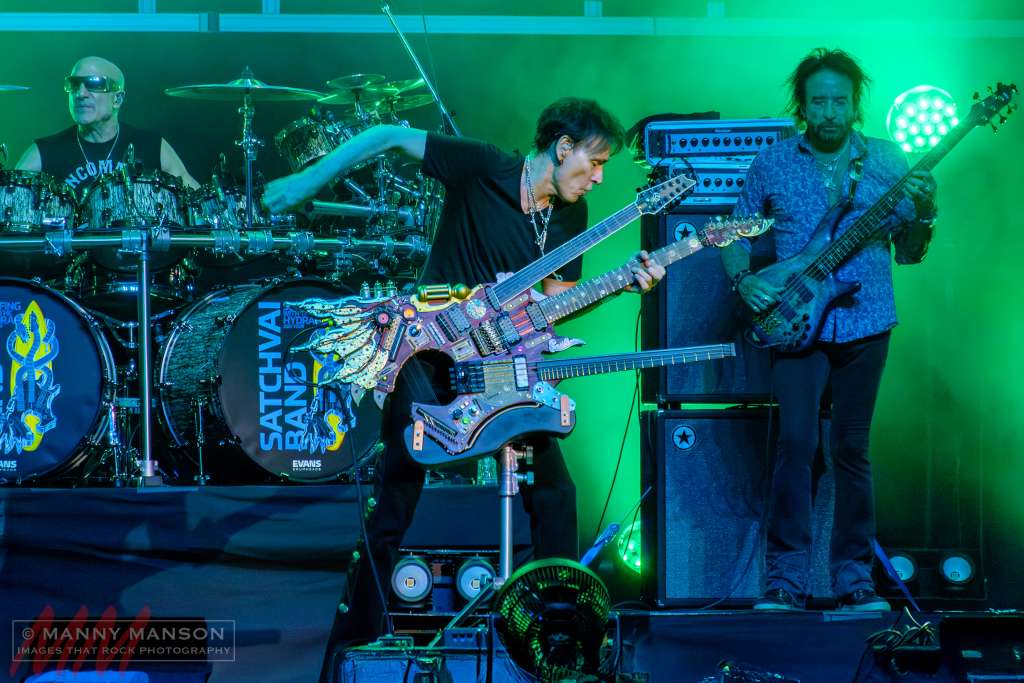
Then came “Little Pretty,” a funkier, more mischievous Vai piece from the same album. Vai coaxed a plucky, hollow tone out of his guitar that bounced like rubber one moment and screamed the next. He mugged playfully to the audience, throwing in staccato runs that seemed to defy the physical layout of the fretboard. Thorne was back beside him, laying down chunky rhythm guitar as Aronoff and Mendoza kept the groove tight as a brand-new drumhead.
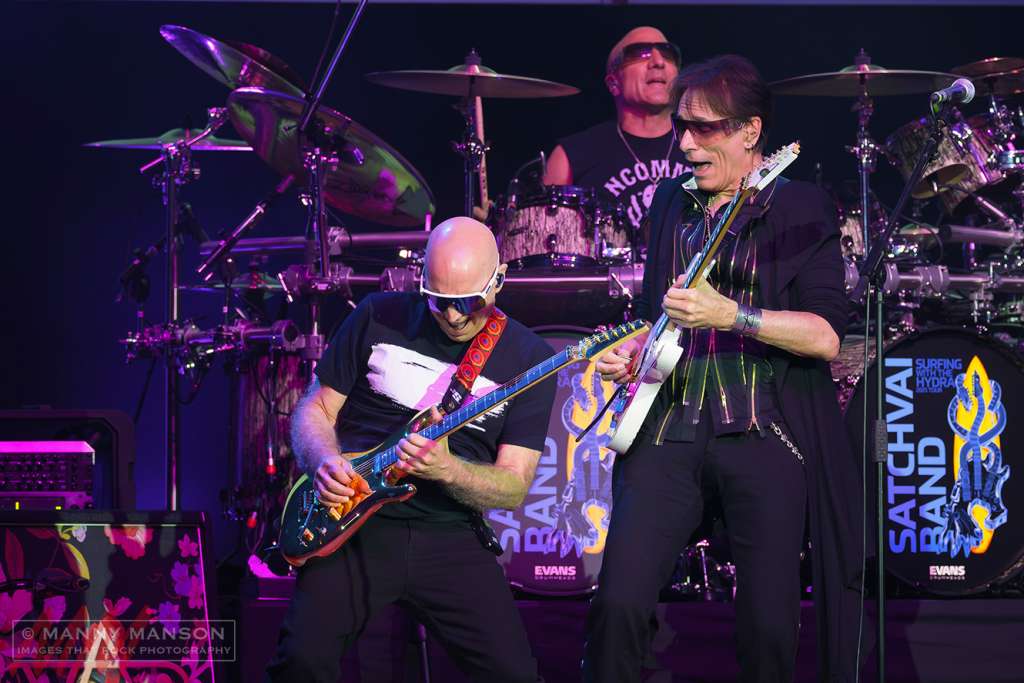
As Vai ended his solo segment, Joe rejoined Steve on the stage and they burst into “Ice 9,” the classic from Surfing with the Alien (1987). The tone was sharper now, with Satriani dialling in his classic ’80s lead sound, compressor, chorus, echo, distortion, all perfectly balanced. The melody leapt and pirouetted, the shared solo leads were full of staccato hammer-ons and complex scale runs, squeals and dive bombs, a full pyro technique delight. It folded almost imperceptibly into “The Crying Machine,” a mid-’90s Vai piece from Fire Garden (1996). The shift in tone was subtle, more soulful bends, a longing in the phrasing, like the guitar itself was struggling to find its words. Vai, full of flash and showmanship flamboyantly led the way, at times staring over Joe’s guitar smiling as they both smashed their whammy bars. The pair then invited Pete Thorn on to the hallowed carpet and allowed him to shine before taking up the reins and the three of them lining up to finish to massive cheers.
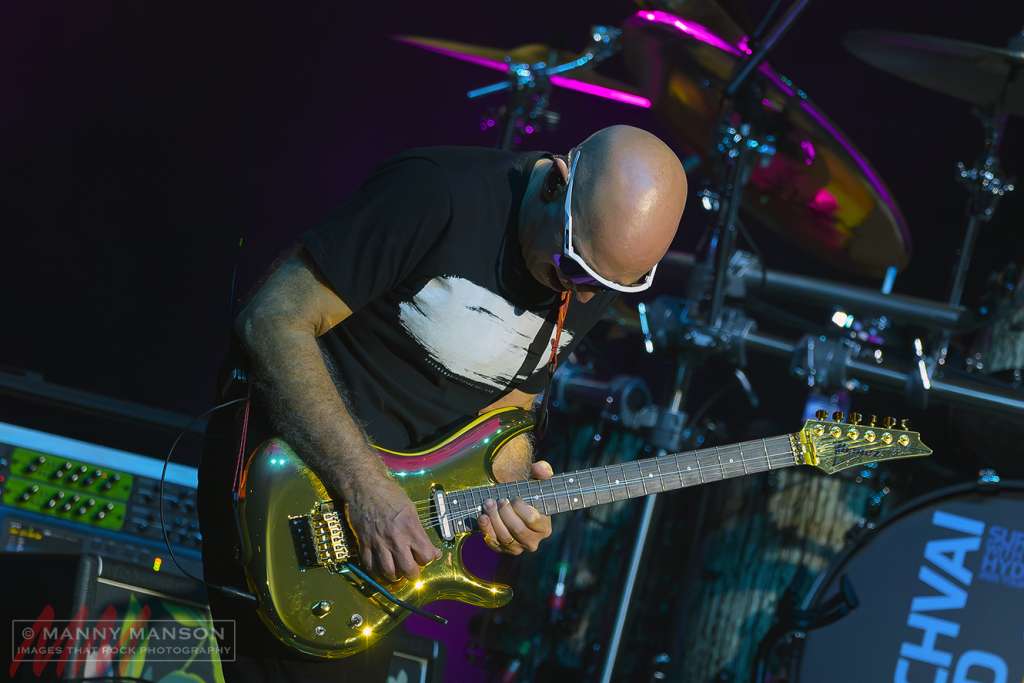
Next came “Flying in a Blue Dream,” the title track from this 1989 release, It’s a song as essential to Satriani as oxygen. The main melody, pure, wordless expression, rang out with crystalline delay trailing behind every phrase. You could almost hear the crowd holding their breath. Joe’s tone here was smoother than earlier, more intimate, almost like whispering confessions. His use of volume swells and legato phrasing gave the illusion of the guitar breathing on its own. The band behind him like cushioned clouds, the screen above showed a carriage traversing the synapses of you mind
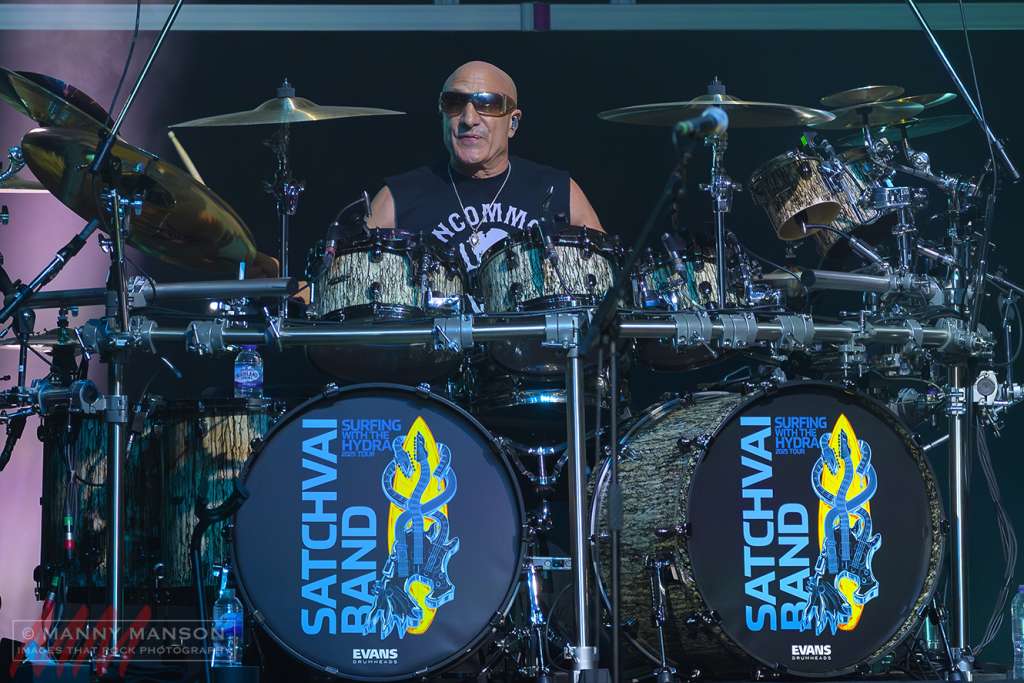
And then, finally, it came, the reason I had discovered Joe Satriani: “Surfing with the Alien.” The place erupted. The unmistakable opening screaming riff, aggressive, angular, thrilling, ignited a sea of heads nodding in time. Vai exited the stage, leaving Joe alone to tear the place apart. He played it just as fast, just as intense as in ’87, but with more fire and nuance. It was a guitar player’s guitar song, and Joe made it feel both furious and effortless. The screen once again transported back to surfer that adorned the album cover. Aronoff was on form his powerhouse drumming slamming into the faces of the partisan crowd. Mendoza was all business-like thunder out a trouser rippling bass line as Pete thorn, smiling, bounced around his side of the stage, like an energised Tigger, fully locked into the groove. As the song built to a crashing finally Aronoff gave us a slam dunk around his kit as Joe brough the house down with a screaming last pitch bend. Yes; the crowd were on their feet applauding this highlight of the night.
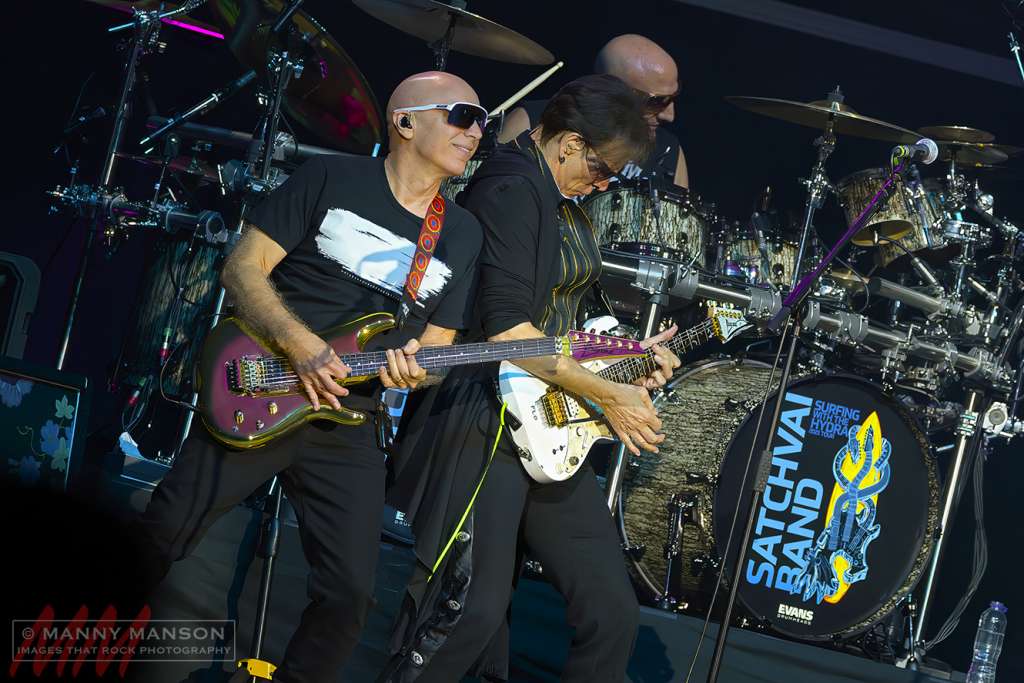
Steve joined Joe back on stage for “Sahara,” the opening from his The Elephants of Mars album (2022). A more recent composition, this track leaned on mysticism and groove, eastern modal scales, dotted with strange harmonic detours and delicate phrasing. Vai picking out a harmony that layered beautifully atop Joe’s lead, the two of them riding the same wave of expression. Steve’s held note mid song was breathtaking in its pureness, as Joe wandered across and joined him mid stage and harmonised together beautifully, the guitars at counterpoint to each other, they ripple whammy barred the song making sound like something from a cheap 1950’s Do Wop themed black and white space movie
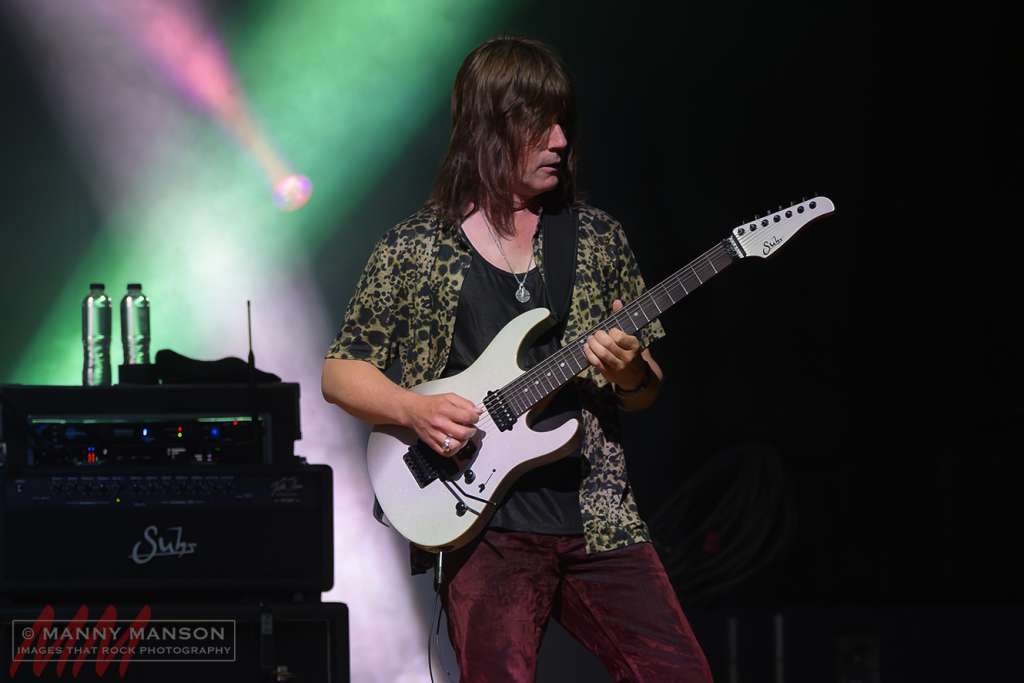
“Tender Surrender” followed, Vai’s signature slow-burn ballad from the EP Alien Love Secrets (1995). It started soft and introspective, Steve pulling long, aching bends from his guitar like prayers, then built into a searing emotional release. No vocals, just pure, writhing guitar, weeping and howling in equal measure. Joe sat this one out and from the side, nodding, seemingly channelling the playing process, as Vai hit that mid song progression, some would say “the best three notes ever written” delivered the goosebumps it was pure alchemy, a dark art that was totally magical and mesmerising.
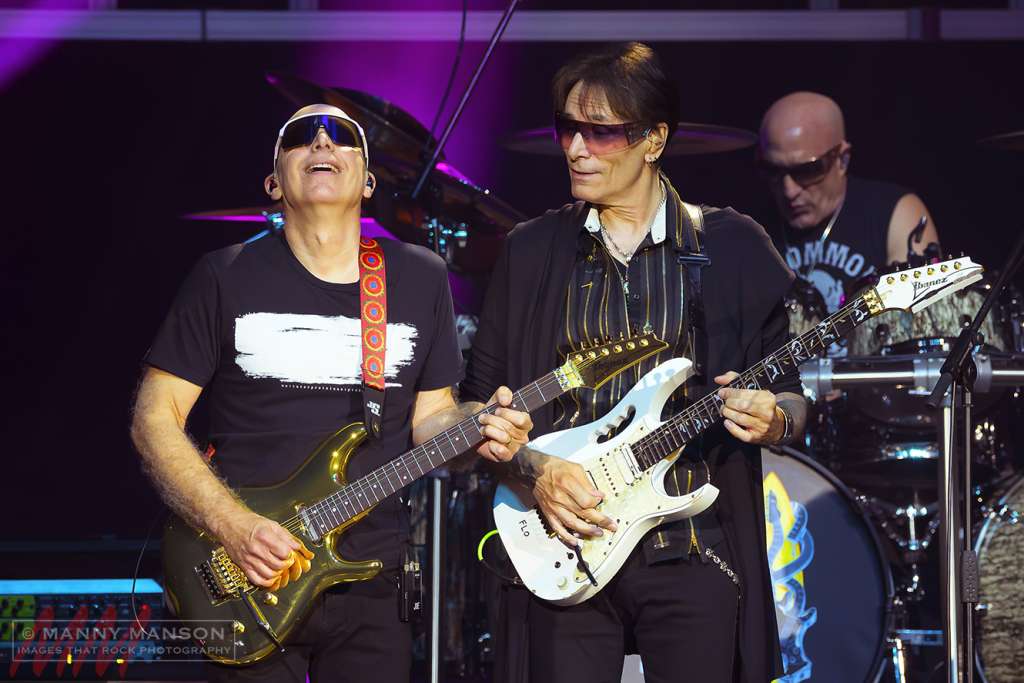
Then the stage darkened, as Steve Wiped himself down. A strange, hulking guitar shaped, obscured from view back a black cloth, was wheeled out: the Hydra. Vai’s monstrous three-necked beast, was revealed, part guitar, part harp, part bass. It was placed in the centre of the stage like an altar. Vai circled it, then dove in. “Teeth of the Hydra,” the opening track from Inviolate (2022), began. The result was not just music, it was theatre worthy of a residence at Caesars Palace or some other grand Las Vegas venue. He tapped and plucked all three necks, pulling off basslines, guitar leads, sitar-like drones, and percussive hits, with the flamboyance of a well-rehearsed, Vegas magician, all live, all in real time. The audience was speechless, as the Wizard took them through a musical ritual, spell bound! No Hydra is not a novelty, but a statement of intent, somewhere to go to when you run out of frets and need to push boundary’s, this time into another world.
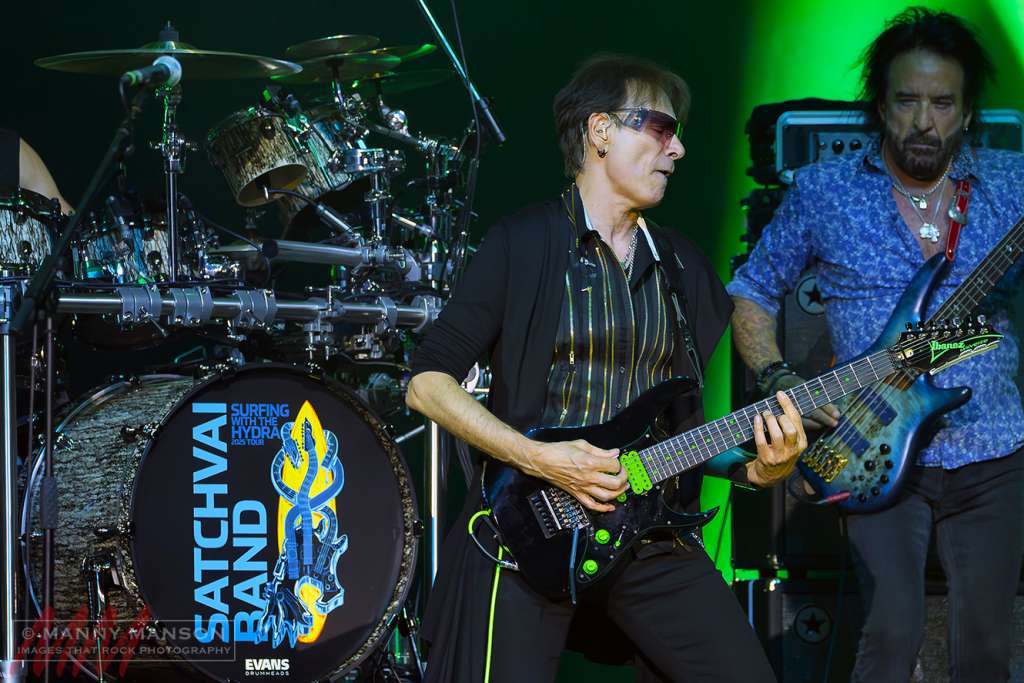
With the Hydra cloaked it and Steve left the stage making way for Joe and the ridiculously clever swing song from Surfin’, “Satch Boogie”, fast, brash, funky. The double-time swing feel kicked in, and Joe tore through the lead lines while Pete Thorne and Mendoza riffed behind him like a pack of wolves. That swung naturally into “If I Could Fly,” a mid-tempo anthem from Is There Love in Space? (2004). The phrasing here was sublime, Satriani’s melodic sensibility at its finest, the perfect bridge between emotion and velocity. Pete Thorn joined in on acoustic guitar as Joe swooped and soared, Joe came back on the stage to duet with Steve as Aronoff and Mendoza thundered along delivering an almost “Harvest for the World” type groove. Steve and Joes guitars talked to each other in an outer worldly voice, totally hypnotic, their heads nodded along to the beat, Pete joined them in the centre, for a moment, creating a crescendo of guitars before Joe and Steve finished off with a slow mix of held notes. Bliss!

Vai took the reins again for “For the Love of God,” his magnum opus from Passion and Warfare (1990). You could have heard a pin drop. Pink spotlights pierced the darkness as the clean opening chords, the swelling string bends, the eventual eruption into that main melody rang out. There was a noticeable shift in the atmosphere, as Vai took you on a journey, his journey, it was transcendental. Joe respectfully played from in front of his rig, to be joined by Steve for some whale song and harmonic arpeggio finger tapping to finish. When the final bend faded out, the place, predictably, erupted once again.
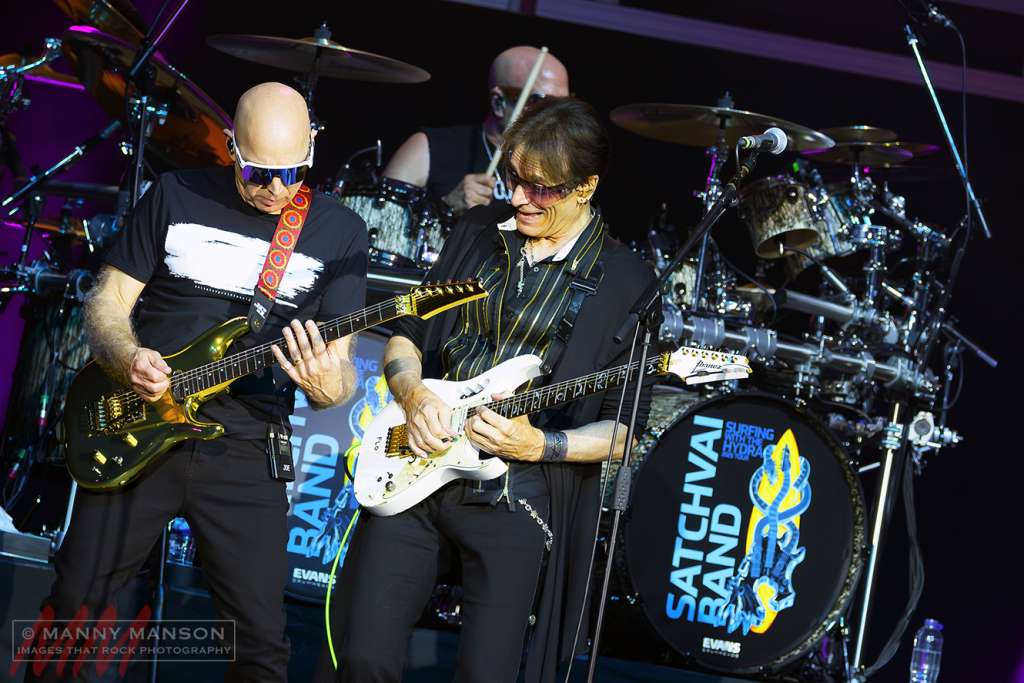
They closed with “Always with Me, Always with You,” one of Joe’s most beloved ballads, also from Surfing with the Alien. But this time, Vai stayed onstage. The two of them played it together, trading phrases, harmonising, echoing each other. It felt like the culmination of decades of shared history between two friends, two voices in one final chorus. As the song built up speed Joe looked across at Pete Thorn, an invite to their show, he marched across, his signature Suhr guitar singing as he joined Satch and Vai for another great guitar moment, Mendoza had now come down from his statuesque pedestal and was thundering out a Tsunami of deep rumbling bass. The four guitars lined up for a mass finish to the show. Mendoza took up the microphone singing “I Get by With a Little Help from My Friends” encouraging the crowd to clap and sing along. The band introductions aside the set was complete, they formed up and bowed to the crowd, they were done! Or were they?
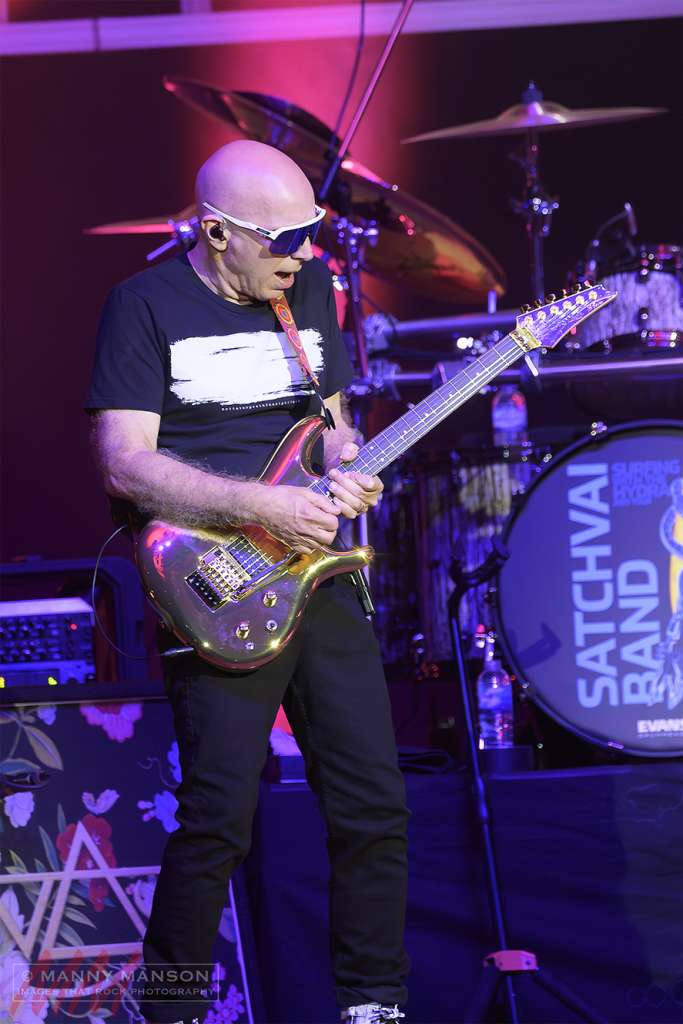
After a brief exit, the crowd chanted for more. The band returned, and Satriani led the crowd in his famous call-and-response guitar chant, obviously called “Crowd Chant” the final song on Joe’s 2006 album Super Colossal. By this point, the entire audience had risen to their feet, clapping and singing. What followed was pure theatre, well to those who hadn’t seen the set list that is: Steve Vai began teasing the intro to “Enter Sandman.” When the riff landed, the crowd went berserk. It turned into a full-blown metal jam, with Satriani and Vai taking turns blazing solos over Aronoff’s pounding drums and Mendoza’s monstrous bassline. At times Mendoza’s voice was drowned out by the fans who were now in full metal mode, their heads nodding faster than the Churchill dog on a cobbled street. And as if that wasn’t enough, they kicked straight into “Born to Be Wild,” a celebration in full swing. Everyone was singing, being led, once again, by Marco, everyone was moving. The band traded solos, Pete Thorne once again proved he wasn’t just a sideman, his solo was fierce, focused, and right on the money, the smiles and riffs flowed with precise fury until the final power notes from all three guitars rang out. No encore needed, the fever ridden crowd were on their feet as one, again the band is introduced to the crowd over wave after wave of riotous applause. The crowd knew what they had witnessed and they were letting the band know it!
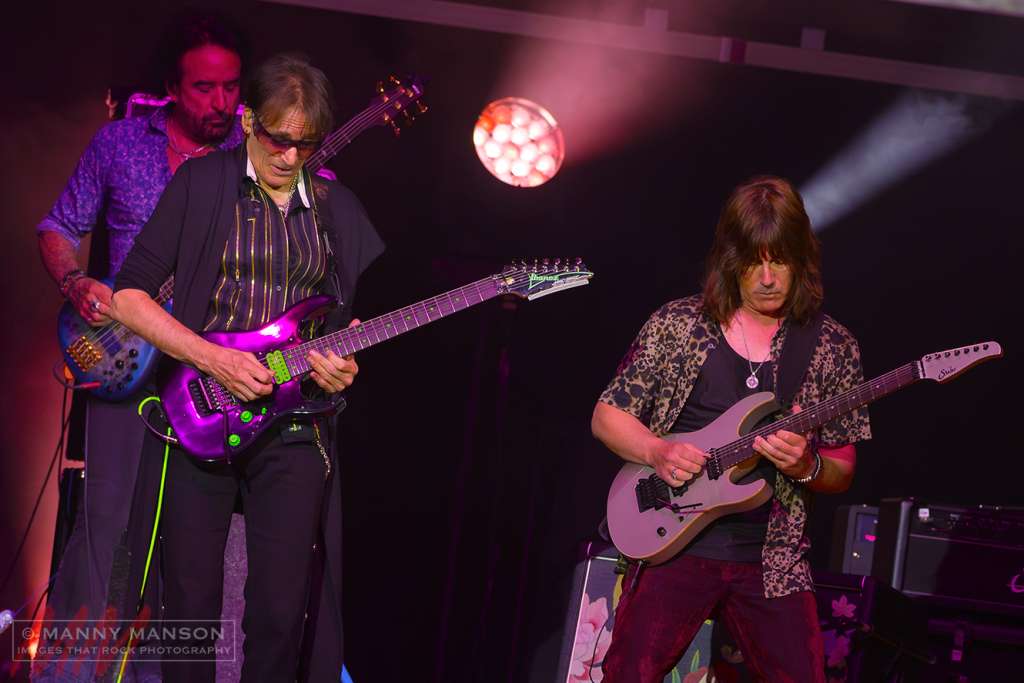
The lights went up and that was that, the show was over. You could taste what lingered in the air, it wasn’t just sound, or memory, of fretless glass guitars, of the Hydra’s many voices, of melodies that refused to fade, there was an aura around the venue. It was a masterclass, a celebration, call it what you will but it was also a reminder of what instrumental rock can still do when the right hands, and the right hearts, are holding those guitars.
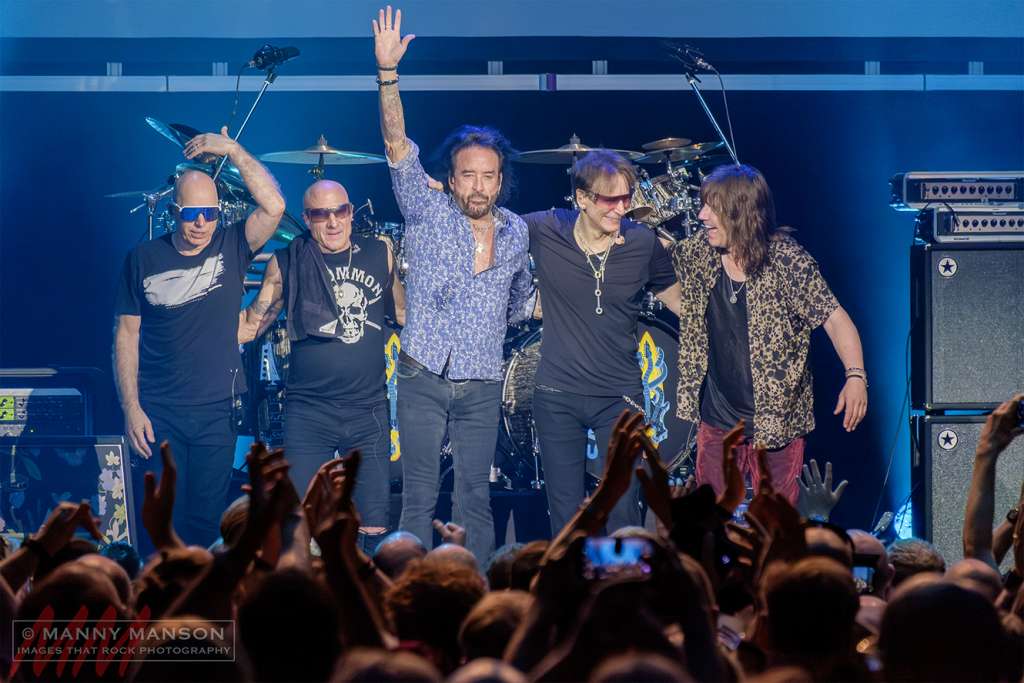
What made this night ‘extra’ remarkable wasn’t just the sheer technical wizardry on display, it was the collision of these three guitarists on a single night, each one pulling from different corners of the sonic universe, created something more than just a concert. Joe’s clean, soaring phrasing, Vai’s explosive polymetric excursions, Ned’s earthy, spectral textures… it was the full spectrum of what a guitar could be. Add in Pete Thorne—whose own background in touring with Chris Cornell and Melissa Etheridge brought a versatile, modern touch, and the solid thunder of Mendoza and Aronoff, and you had a band that felt both virtuosic and human. That’s a rare thing.
Together, they reminded us why we still gather in dark rooms with wooden stages and bright lights. Because in the hands of masters, an electric guitar isn’t just a tool. It’s a voice, a paintbrush, a weapon, and a prayer. And in Wolverhampton, for one surreal evening, it spoke with many tongues—and every word rang true.







